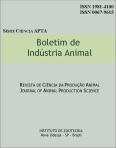Reproductive traits as cause of variation in milk yield
Abstract
Production data recorded over a period of 15 years for Holstein cows were analyzed in order to establish the effect of gestation length, calving interval before lactation, and days open during the current lactation on milk and butterfat yield. The herd studied is maintained in a region of the State of São Paulo, Brazil, which, during the period analyzed, had a mean yearly temperature of 200C, mean yearly rainfall of 1,230 mm, and less than 85% relative humidity. Farm management is satisfactory, with plentiful feed based on silage and green fodder, and supplementation provided according to yield. Nonadjusted means of milk yield, fat yield and fat percentage for 2,987 observations over 318 lactation days with twice daily milking were: 4,456 ±28kg (CV =34%); 165.0± 1.1 kg (CV =32%) and 3.60 ±0.01 (CV = 11%), respectively. The reproductive traits analyzed showed the following mean values and standard errors (in days): 278 ± 0.6, 438 ± 2.1 and 160 ±20 for gestation length (GL), calving interval (Cl) and days open (DO), respectively. Analysis of variance by least squares method included the following effects in addition to the previously mentioned reproductive traits: progeny sex, month and year of calving, cow age and lactation length (linear, quadratic and cubic effects). All effects included in the model were significant, except progeny sex and gestation length. The effect of Cl on milk and fat yield was best described by linear and quadratic equations, whereas the effect of DO on milk yield was best described by quadratic and cubic equations. In general, yield increased with Cl preceding lactation up to about 400 days and with number of days open during the current lactation up to 150 days, with no definite tendency shown after this period.Downloads
Downloads
Published
Issue
Section
License
Os autores não serão remunerados pela publicação de trabalhos, pois devem abrir mão de seus direitos autorais em favor deste periódico. Por outro lado, os autores ficam autorizados a publicar seus artigos, simultaneamente, em repositórios da instituição de sua origem, desde que citada a fonte da publicação original seja Boletim de Indústria Animal. A revista se reserva o direito de efetuar, nos originais, alterações de ordem normativa, ortográfica e gramatical, com vistas a manter o padrão culto da língua e a credibilidade do veículo. Respeitará, no entanto, o estilo de escrever dos autores. Alterações, correções ou sugestões de ordem conceitual serão encaminhadas aos autores, quando necessário. Nesses casos, os artigos, depois de adequados, deverão ser submetidos a nova apreciação. As opiniões emitidas pelos autores dos artigos são de sua exclusiva responsabilidade. Todo o conteúdo deste periódico, exceto onde está identificado, está licenciado sob a Licença Creative Commons Attribution (CC-BY-NC). A condição BY implica que os licenciados podem copiar, distribuir, exibir e executar a obra e fazer trabalhos derivados com base em que só se dão o autor ou licenciante os créditos na forma especificada por estes. A cláusula NC significa que os licenciados podem copiar, distribuir, exibir e executar a obra e fazer trabalhos derivados com base apenas para fins não comerciais.













